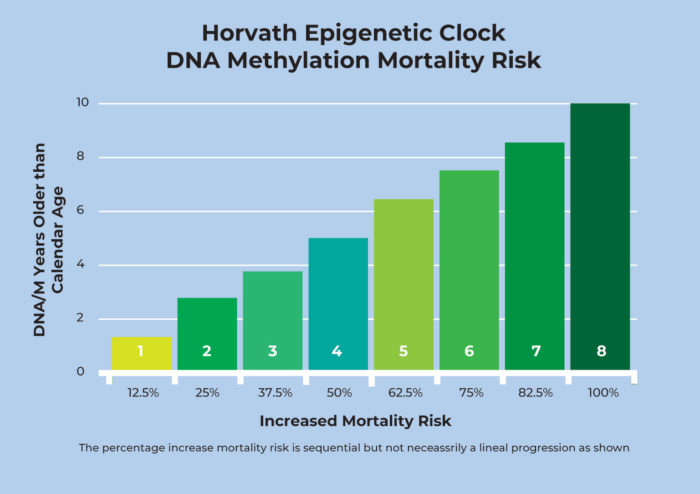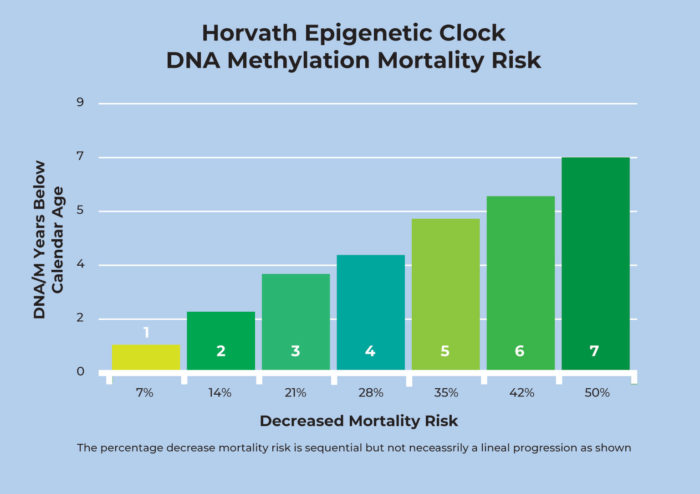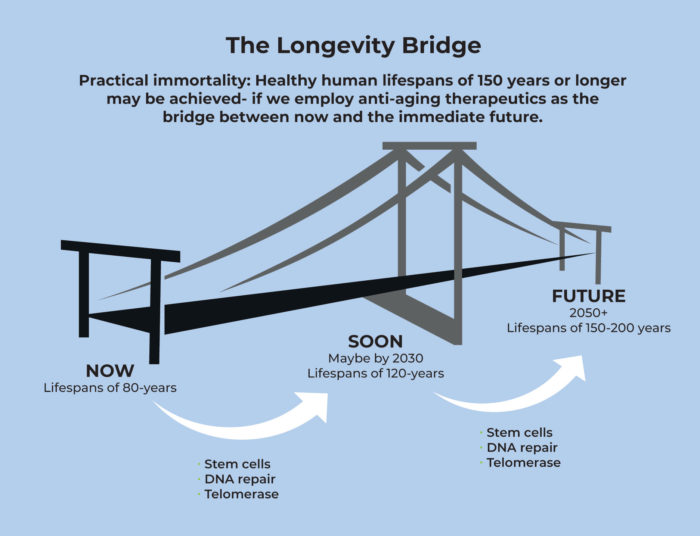
Reversing biological aging with peptide bioregulators
October 13th, 2022An interview with Dr. Bill Lawrence by Phil Micans
Ed.- Three years ago, I had the pleasure to interview Dr. Bill Lawrence in a piece entitled ‘forever young.’ It appeared in issue 1 of the 2019 Aging Matters™ magazine. At that time, Dr. Lawrence had begun the 3-year journey to apply peptide bioregulators (PB) to 39 patients. Today, it’s 3-years later, so we get to find out what happened! Note: PM is me, and BL is Dr. Lawrence.
PM: Bill, I’m so excited to chat with you again and learn how the participants have performed in your studies.
BL: Thanks, Phil. I am happy to provide an update.
PM: Before we get into that, I recommend that people read our original interview (outlined above) but would you mind doing a quick recap? In other words, what made you do this study in the first place?
BL: As I mentioned in the previous interview, my primary motivation was self-preservation. Unfortunately, all the males in my family experience premature death, commonly in their fifties and early sixties, including my father at age sixty-four. I am now seventy-six. I was thirty-seven when my father died and based on family history, I had already lived more than half my probable lifespan. At that time, I was a tax and estate planning attorney and an entrepreneur building medical buildings, shopping centers, etc. Around that time, a wealthy eighty-year-old estate planning client in poor health told me he would give up his entire wealth if he could have just ten more years of healthy life. That was one of those life-changing moments as I realized my priorities needed to change. So, I sold everything, returned to graduate school, and became a biogerontology researcher. Somewhere along the way, I had an epiphany. Most of us, especially those north of sixty, feel time has accelerated or, as people often say, “it’s flying by.” We start our week on Monday, and suddenly it is Friday, or it’s February, and next thing we know, we’re carving the Thanksgiving turkey. The epiphany was I could not slow time down, but it may be possible to add more time. I can add a decade, perhaps several, to my life by reversing biological age. At the end of this interview, I will mention the ‘Bridge’ strategy, which, as a scientist, I believe will allow me to add another thirty or more years to my life.
Russian clinical studies with peptide bioregulators
BL: My first exposure to Peptide Bioregulators came in 2013 when I discovered a published longevity study by Professor Vladimir Khavinson, Director of the St. Petersburg Institute of Bioregulation and Gerontology. The study was summarized in the 2019 Aging Matters™ interview. The twelve-year study reported a dramatic reduction in all-cause mortality in an elderly control group using Dr. Khavinson’s peptides, principally the pineal gland and thymus. However, it was extraordinary that the significant mortality reduction was achieved using only two peptides, which were only used during the first three years! I later understood the peptides accomplished this by cellular rejuvenation or reprogramming.
PM: At that time, the three principal PBs in use were the pineal, the thymus, and the blood vessels. Did you just use them, or others too?
BL: Today, there are twenty-one natural food-based peptides, otherwise known as Cytomaxes®. We use all of these in our studies. The expanded number of peptides will produce even more significant longevity and health span benefits than the original trials.
2019 study summary
Subsequently, I met with Professor Khavinson, became affiliated with the St. Petersburg Institute, and we agreed to an American study to confirm the peptides were an effective cellular rejuvenation intervention. While there are many claims for products and substances for cellular rejuvenation. I am unaware of any intervention other than Peptide Bioregulators, with human clinical study proof of cellular regeneration. One possible exception might be stem cell therapy, especially VSEL [Ed.- Very Small Embryonic Like Stem Cells]. The rejuvenation or regeneration of human stem and other cells results in tissue, organ, and system regeneration, i.e., endocrine, central nervous, respiratory, lymphatic, etc. When organ/ system regeneration occurs, the result is enhanced longevity and health span, and a true biological age reversal.
PM: Those Soviet studies were truly remarkable; their size and time-period is unheard of in the west.
Peptide clinical study overview
BL: Indeed and of course human longevity or longitudinal studies require decades to complete. Our studies use the reversal of biological age biomarkers as a proxy for longevity intervention. Biological age is an estimator that predicts a person’s health and present life expectancy. On the other hand, chronological age is simply the time that elapses since birth. Aging in humans is a complex and multi-stage process. Therefore, it is impossible to compress biological age into a single test or number. While there are many ways to estimate biological age, most biogerontologists would generally agree that improvement in telomere and DNA methylation (DNA/m) biomarkers represent two of the more accurate biological age markers available now. Evidence of biological age reversal would be the modification of biological age markers, Telomerase activation results in telomere restoration, allowing increased cellular replication. Cell replication is a primary determinant supporting extended lifespan. Numerous published studies confirm that longer telomeres are associated with longevity and enhanced health. Modification of age-related methylation measured by the Horvath Epigenetic Clock is believed to be a primary longevity and organ regeneration intervention.
PM: Just a reminder for folks to get more background information by reading our V3 issue 1, 2019 article in Aging Matters™ available online to download. Also, more specific information is available from several interviews with Dr. Lawrence on YouTube by searching ‘Bill Lawrence Peptides.’ Meanwhile, maybe it’s worth just taking a step back for a moment to ask:
What are peptides?
BL: These peptide bioregulators are short-chain amino acids derived from food. Specifically, these peptides are chains of 2 to 4 amino acids sourced from food molecules derived from young calves with small molecular weights. As a result, they activate stem cell function and penetrate cell membranes and nuclear membranes for epigenetic regulation of gene expression and activation of the telomerase enzyme. Russian and European clinical peptide studies prove that these peptides can significantly increase human longevity and reduce all-cause mortality. The result is enhanced life and health span, defined as the number of years without significant age-related disease and organ degeneration.
Professor Khavinson has been quoted: “Peptide Bioregulators regenerate organs impaired by aging, disease, and trauma. The peptides developed at the St. Petersburg Institute of Bioregulation and Gerontology constitute a proven biological reprogramming technology, rejuvenating cells to revitalize tissue/ organs and entire bodies, ultimately decreasing vulnerability to age-related degeneration and prolonging human life.” The peptides were initially developed on behalf of and used by the Soviet Union Military, Cosmonaut space program, and their Olympic athletes.
The studies
BL: We commenced two separate peptide studies. The goal of both studies is to determine if and to what extent peptides can reverse and improve two essential biomarkers of biological aging, telomeres, and DNA/m. The telomere study, Telomerase Activation Protocol (TAP), started in 2017. Prior published studies had proven these peptides could lengthen telomeres. The remaining question was, do longer telomeres extend and enhance longevity and health span? Several thousand published studies have now confirmed the answer is yes. There is a consensus among gerontology scientists, supported by numerous studies, that one of the most critical aging causes in humans is the progressive shortening of telomeres, especially in human stem cells, because of cell replication. Humans age because their stem cells age. Peptides activate an enzyme, Telomerase, which maintains and lengthen telomeres in stem cells. This results in better stem cell function/ cellular rejuvenation and slower organ and organism aging. Numerous clinical studies confirm people with longer telomeres experience extended and healthier lives. For additional telomere background information, I recommend the Telomerase Revolution book by Dr. Michael Fossel.
Fossel’s book photo
Telomere age
PM: So, when it comes to biological age, how is it reversed by lengthening telomeres?
BL: Well, if a person’s baseline telomere measurement reports telomeres equivalent to a seventy-year-old, this is their baseline telomere ‘age’, which will be older or younger than their chronological age. If older, we refer to this as accelerated telomere aging. Let’s assume that their telomeres have been lengthened after a peptide protocol, equivalent to a fifty-year-old. This becomes their reduced telomere age. Success is adding telomeres to the end of the chromosome via peptide-induced telomerase activation, allowing more cell replication, and reported as a reduction in telomeres age.
PM: And how have your patients performed in this regard?
BL: At the end of three years, over sixty TAP participants had an average telomere age reversal (lengthening) equivalent to approximately twenty-two years. On average, participants experience a telomere lengthening of about seven years for each year in the study.
PM: Wow! Are there any goals/ aims?
BL: For a participant over sixty, the telomere goal is to reset their telomeres equivalent to a 30- to 40-year-old. This was proof the peptides could reverse this biomarker of biological aging. The telomere study is now entering its fifth year. Today, there are over one hundred participants, either active or after achieving their telomere goals, on a minimal maintenance program. At seventy-six, my telomere length range is between those of a 35- to 45-year-old.
PM: And why was it necessary/ important to also study DNA methylation?
Epigenetic Methylation Study (EMS)
BL: The second peptide study commenced in early 2020 to determine if peptides can reverse Epigenetic Age (DNA/m). Methylation is one of the essential chemical processes that our bodies use to ensure our genes work correctly. Some scientists describe methylation as the ‘Windows operating system for the body.’ As we age, especially in older humans, or those with unhealthy lifestyles, diet, toxic environments, chronic stress, etc., there are changes to our DNA caused by methylation. Some refer to this as ‘methylation rust’ or age-related ‘toxic’ methylation. Eventually, human aging and the epigenetic influences result in methylation found at specific DNA sites, turning off certain generally protective genes and turning on genes that promote aging. The body is a complex organism with various ‘gears and switches’ that must function correctly to operate optimally. Think of methylation as the mechanism that allows the gears to turn and biological switches to be turned on and off for a host of systems in the body. Unfortunately, as humans age, methylation levels increase (chemical methyl tags) and cause the gears and switches (DNA) to malfunction. Different lifestyle and behavioral factors such as diet, sleep, exercise, smoking, and drinking alcohol can also affect the composition and location of the chemical groups that bind to our DNA. Environmental factors such as stress, trauma, or even neighborhoods or zip codes may also impact. Early life adversity, chronic stress, childhood health, personality, intelligence, and less measurable but vital puzzle pieces such as social connectedness, isolation, and a sense of purpose throughout our lives affect methylation. Early adversities accelerate epigenetic aging long after they occur, in proportion to the total number of such experience. Dr. Steven Horvath, a professor and biostatistician scientist at UCLA, discovered hundreds of age-related DNA sites (CpG Islands) where methylation changes could be observed, affecting DNA and, ultimately, age-related genes. Additional research revealed that a DNA biological age (EpiAge®) could be calculated based on methylation status.
Dr. Horvath created the ‘Horvath Epigenetic Clock’ to measure epigenetic methylation status and report an Epigenetic age compared to chronological age. The Horvath Clock is considered one of the current most accurate assessments of biological age as a potential predictor of future mortality.
Photo of Dr. Steven Horvath
Epigenetic age reporting
BL: Several commercial labs can analyze methylation and determine an epigenetic biological age from that information. This is reported as Epigenetic Age/ EpiAge® or, as one lab prefers, TruAge®. Like telomere reporting, comparing baseline EpiAge® and post peptide protocol EpiAge® is evidence that peptides can modify and reverse this aspect of biological aging. These testing technologies confirm peptides are effective cellular rejuvenation interventions. Our EMS clinical study goes beyond a resetting of EpiAge®. It also determines a participant’s all-cause mortality risk. Dr. Horvath’s research discovered if a person has an EpiAge® ‘age’ eight or more years greater than their chronological age, their all-cause mortality risk is 100% greater than their same-age peers. Conversely, if a person’s EpiAge® age is seven years less than their chronological age, their risk of death is reduced by 50% compared to their peers. Dr. Horvath acknowledges that the ‘Horvath Clock’ accurately measures biological versus chronological age. His frustration is not being aware of any effective intervention to modify the ‘toxic’ or age-promoting methylation. Preliminary two-year results for the EMS clinical study suggest Peptide Bioregulators can reduce age-related ‘toxic’ methylation levels resulting in a reversal of the Horvath Clock and a significant reduction of all-cause mortality. The EMS study goal is to use the peptides to reduce all-cause mortality risk as measured by the Horvath Epigenetic Clock. The tentative results are very positive with our first eighty-three participants.
ADD BAR CHARTS OF INCREASED AND DECREASED RISK
PM: What are you typically finding with your study participants?
BL: On average, a new EMS participant will often be 2 to 4 years ‘older’ than their chronological age. According to Dr. Horvath’s research, this represents a 25% to 50% increase in all-cause mortality risk. After two years on a peptide protocol, the average participant reduced their EpiAge® by about five years. That may not seem significant compared to decades of telomere age reduction but quantifying the two biomarkers is not comparable. A positive outcome with telomere peptide interventions (lengthened telomeres) is reported as a ‘telomere age’ versus chronological age. This is based on telomere length (base pair) measurement. As telomeres lengthen from the average seventy-year-old to those found in a forty-year-old, it reflects a reduction in telomere biological age. Epigenetic age is reported similarly but is far more complex than telomere assessment as it involves the entire body (systems and organs), methylation, and gene analysis. First, an epigenetic baseline ‘age’ is assessed and compared to chronological age. Post peptide intervention after testing then reports a reduced epigenetic biological age. Both types of biological age reporting are helpful but primarily serve to confirm progress in reducing biological age markers. Therefore, both these age biomarkers reported a biological age as a number. However, Dr. Horvath discovered that epigenetic age is also linked to mortality risk. Therefore, this EpiAge® is essential to assess all-cause mortality risk rather than simply evaluating biological age. In the EMS study, we focus primarily on the difference between EpiAge® and chronological age because it relates to mortality risk. We refer to this as the ‘gap.’ Unlike telomere age assessment (telomere versus chronological age), success is determined by increasing the positive gap between present chronological age and EpiAge®.


PM: What is important about this gap?
BL: Well, if a new participant has an EpiAge® two years older than their chronological age, they have an increased risk of all-cause mortality of 25% compared to their same-age peers. We refer to this higher risk as a two-year negative gap. Conversely, if the participant’s EpiAge® is two years less than their chronological age, this is referred to as a two-year positive gap. The initial goal is to reduce their EpiAge® to their chronological age. This reverses an increased mortality risk to neutral (same risk as their peers) or a neutral gap. The next stage is to create a positive gap. If the peptide protocol reduces their EpiAge® an additional four years less than their chronological age, we define this as a four-year positive gap. At four years less than chronological age, the all-cause mortality risk is now about 30% less than the participant’s peers. Our goal is to achieve a seven-year positive gap. Then their all-cause mortality risk is 50% less than their peers. On a personal note, my most recent EpiAge® test reports show that I have a positive gap of ten years. This represents a potential all-cause mortality risk that’s 70% less than my peers of the same chronological age.
PM: Impressive, how do these results compare with other antiaging methodologies?
BL: I am unaware of any other medical or health intervention, technology, pharmaceutical, nutraceutical, or substance, confirmed with scientific evidence that can reduce all-cause mortality by even a small percentage.
Clinical study procedure
PM: So, what is the typical procedure for a patient?
BL: We perform baseline telomere and EpiAge® testing with each study participant. The results reveal their telomere and EpiAge® compared to their chronological age. Based on that data and any health issues they want to address; we design a peptide protocol unique to each person. This generally is 5-7 different peptides per month (thymus, pineal, heart, brain, kidney, etc.) Then, over a year, we rotate through all the twenty-one peptides. The dosage is generally two capsules per day for ten days each month and then off the specific peptide for twenty days. This cycling or pulsing avoids organ reliance on the peptides. Instead, the goal is cellular rejuvenation, tissue enhancement, and organ regeneration such that the specific organ is restored and functioning independently. The peptide program is typically three to four years and then onto maintenance if desired. This is very different than conventional Western medicine, where a patient is likely to remain on medication for their entire life.
PM: And what were some of the initial reactions? i.e., were there any kind of differences noted?
BL: Yes, there were significant improvements in their telomeres with lengthened telomeres and in their Epigenetic Age- with a reduction in all-cause mortality risk biomarkers. In addition, both studies report improved energy, sleep, skin, and cognitive and physical function. While not intended for medical treatment, participants’ blood tests highlighted significant improvements in various organ functionality markers, such as the kidney and liver, etc.
Clinical study results
PM: Very nice, and on average how well do most people perform?
BL: Over 90% of the telomere participants reach their telomere goal in 2 to 3 years. Furthermore, the average participant over three years reduces their telomere age by twenty-two ‘years.’ We are just now reaching the two-year mark in the Epigenetic study. Interim results reflect a high percentage of participants who have reversed their EpiAge® on average by approximately five years. This typically shifts them from the increased risk to the decreased mortality risk group. We believe that in another couple of years, these participants will have reached their optimal goal of seven years less than chronological age and achieved a mortality risk of fifty percent less than their peers.
PM: How many persons are in these studies today?
BL: Over one hundred and twenty people, primarily physicians and other health providers, are now participating in the two studies. There are nearly ninety active participants in the testing and full peptide protocol. The remaining have met their goals, and everyone in this group has chosen to stay on a minimal maintenance peptide program. Three people have left the studies due to geographic moves to other countries. Four people have left the program due to financial stress caused by Covid government mandates.
Adverse effects
PM: Were there any side effects or other issues?
BL: The peptides are sourced from young calves and are classified as food supplements; they have been used in Russia for over forty years on hundreds of thousands of people with no adverse effects.
PM: And as your trial continued- I might add all during the difficult time of CV19 lockdowns- did anything else appear or change?
BL: Yes, participants exposed to the spike protein from the Covid virus and the ‘vaccines’ are experiencing accelerated cellular aging. This is caused by impairment of the cellular DNA Repair Mechanism. About 8% of the participants in the two studies reported Covid virus infection and/ or vaccine injections. All of them have experienced accelerated aging caused by the spike proteins. We are addressing this situation with a DNA Repair Mechanism protocol consisting of peptides, nutraceuticals, and spike protein interventions.
The bridge
PM: What do you see as the next big step to extreme longevity?
BL: I’d like to take a moment to explain my longevity strategy for living well beyond one hundred years. I call this the Bridge. It is based on employing antiaging therapeutics now available and those soon available as the bridge between now and the immediate future. The idea is that one must create the highest degree of physical, mental, and emotional health possible today. Then maintain that level over the next ten years (crossing the bridge). Sometime in the next decade, when one arrives at the other side of the bridge, the most common causes of death and disability will have been resolved. Heart disease, diabetes, dementia, cancer, etc., will likely have cures or become chronic, manageable conditions.

Schematic of the longevity bridge
There are dozens of well-funded biotech companies attempting cellular reprogramming to treat age-associated diseases and potentially rejuvenate tissues and organs. Billions have been spent and invested using the following and developing interventions using Quantum Computers, artificial intelligence. CRISPR (genome sequencing), gene sequencing and therapy, stem cells and exosomes, replacement organs by 3D printing, robotics, nanotechnology, microrobots, etc. Most of these will be available in the next decade. The key is to stay as healthy as possible and remain on the cutting edge of longevity interventions to take advantage of these technologies as they become available. Peptide Bioregulators are the only intervention presently available I am aware of that causes cellular rejuvenation or reprogramming. Therefore, Peptide Bioregulators are essential and the key for crossing the longevity bridge.
PM: And finally, in a short statement, what would you say has been accomplished in this 3-year PB trial?
BL: We’ve reversed these patients’ biological age, reprogrammed, or regenerated their organs and systems via cellular rejuvenation, and significantly reduced their all-cause mortality risk.
PM: This is quite remarkable, and yet currently, it’s not hardly known even in the longevity field. Hopefully, that will change very soon, and we will certainly want to revisit this subject. Thank you, Bill, for your time, efforts, and dedication to making this happen.
BH: My pleasure Phil.
END









